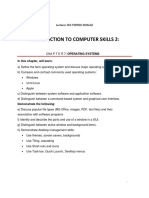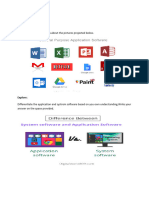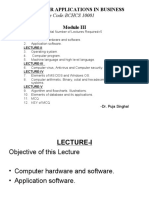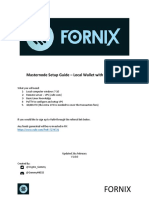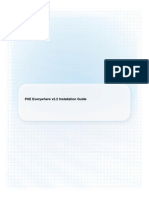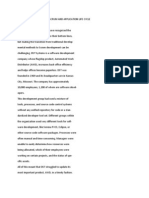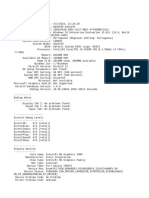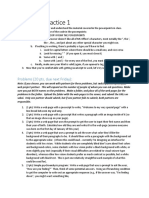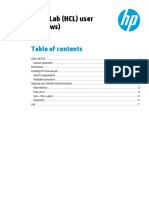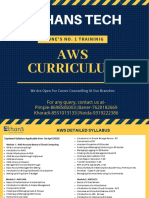Practical Software Work
Uploaded by
ScribdTranslationsPractical Software Work
Uploaded by
ScribdTranslationsSoftware
Software is an essential ingredient for operation
of the computer. It is made up of a series of instructions and data,
that allow taking advantage of all the resources that the computer has,
so that I can solve a large number of problems. A
the computer itself is just a conglomerate of components
electronics; the software brings the computer to life, making its
components function in an orderly manner.
1. SYSTEM SOFTWARE: These are programs that
they allow the management of the physical part or the resources of the
computer, it is the one that interacts between the user and the components
computer hardware. Operating Systems are classified
Single-user and Multi-user
2.APPLICATION SOFTWARE: These are the programs that we
they assist with specific tasks such as text and image editing,
calculations, etc. also known as applications.
Software classification
Proprietary software A Operating System (OS) is in itself a
computer program. However, it is a very special program, perhaps
the most complex and important in a computer. The OS wakes up the
computer and makes it recognize the CPU, the memory, the keyboard, the
video system and disk drives.
SHAREWARE: a distribution modality ofsoftware, in the
that the user can evaluate the product for free, but with
limitations on the usage time or on some of the forms of use or
with restrictions on final capabilities.
FREWARE: define a type ofnon-free softwarethat is distributed without
cost, available for use and for unlimited time.
FREE SOFTWARE: it is the designation of thesoftwarethat respects the
freedomfrom the users about their purchased product and therefore a
once obtained, it can be used, copied, studied, modified and
freely redistributed.
Operating System (OS) is itself a computer program.
However, it is a very special program, perhaps the most complex and
important on a computer. The OS wakes up the computer and makes it
recognize the CPU, memory, keyboard, video system, and drives
of disk
The most well-known operating systems are as follows:
1) DOS: The famous DOS, which stands for Disk Operating System.
disk operating system), is more commonly known by the names PC-DOS and MS-DOS.
MS-DOS was created by the software company Microsoft and is essentially the
same OS as PC-DOS.
The reason for its continued popularity is due to the overwhelming volume of
available software and the installed base of computers with processor
Intel.
When Intel released the 80286, DOS became so popular and established in the market.
that DOS and DOS applications represented the majority of the market of
software for PC. At that time, IBM compatibility was a necessity
for the products to be successful, and 'IBM compatibility' meant
computers that ran DOS as well as IBM computers did
they did.
Even with the new operating systems that have come onto the market, still the
DOS is a strong contender in the OS war.
2) Windows 3.1: Microsoft made a decision to create an operating system that
it had a user-friendly graphical interface, and as a result obtained
Windows. This system displays icons on the screen that represent
different files or programs, which can be accessed by double clicking them
click with the mouse pointer. All the applications developed for
Windows look similar, so it is very easy to learn to use new software.
once the basics are learned.
3) Windows 95: In 1995, Microsoft introduced a new and improved version of
Windows 3.1. The improvements of this OS include multitasking support and
32-bit architecture, thus allowing better applications to run for
improve work efficiency.
4) Windows NT: This version of Windows specializes in networking and
servers. With this OS, it is possible to interact effectively between two or more
computers.
5) OS/2: This OS was made by IBM. It has 32-bit support and its interface is
Very good. The problem with this operating system is that it is not given
give dad the support he deserves regarding applications. That is to say,
not many applications have been created that take advantage of the features of
the OS, since the majority of the software market has been monopolized by
Windows.
6) Mac OS: Macintosh computers would not be as popular as they are.
if they did not have Mac OS as the main operating system. This system
the operating system is so user-friendly that anyone can
learn to use it in a very short time. On the other hand, it is very good for
organize files and use them effectively. This was created by Apple.
Computer, Inc.
7) UNIX: The UNIX operating system was created by Bell Labs.
AT&T in 1969 and is now used as one of the foundations for the superhighway.
of the information. Unix is a multiuser and multitasking OS that runs on
different computers, from supercomputers, mainframes,
Minicomputers, personal computers, and workstations. This
it means that many users can be using the same computer
by means of terminals or using many of them.
Convenience. An Operating System makes usage more convenient.
from a computer.
Efficiency. An Operating System allows the resources of the
computers should be used as efficiently as possible.
Ability to evolve. An Operating System must be built
in a way that allows for effective development, testing, or introduction
of new system features without interfering with the service.
In charge of managing the hardware. The Operating System
in charge of better managing the resources of the
computer in terms of hardware, that is, assign to
each process a part of the processor in order to share them
resources.
Relate devices (manage through the kernel). The System
The operation must take care of communicating to the devices
peripherals, when the user requires it.
Organize data for quick and secure access.
Manage network communications. The Operating System allows the
user can handle everything related to the installation with great ease
and use of computer networks.
Byte stream processing through the data bus.
Facilitate inputs and outputs. An Operating System must do so
easy for the user to access and manage the devices of
Input/Output of the computer.
Of productivity: This type of software is of the type of
the previously mentioned (word processor, spreadsheet,
etc.), and these are used to facilitate many of the tasks of type
"office". For example, the word processor facilitates the
preparation of work or reports.
2. For entertainment: This is one of the most popular
around the world, since they are found the so-called
"little games". This type of software includes games
from table to elaborate bloody and violent games. The
the software industry will always receive huge amounts of
income from this type of software.
3. In business: Here are the programs that
they are used to manage the finances of a business, for example, a
program that records the items sold in a certain
time and then shows the profits.
4. Of education or reference: The education software is
that one which, as its name suggests, serves for education or
learning. In this are the encyclopedias
electronic, the interactive programs for learning
mathematics, physics, anatomy, etc., the programs that help
to learn the use of a specific type of software, etc. In short,
we have all used or will use one of these someday, so
It is essential to know how they function in order to know how to use them.
correctly and make the most of the features
by each of them. Collaborated by: Tomas del Corso, as
collaboration mode forAgendistas.com







